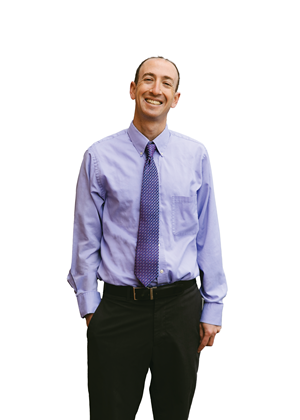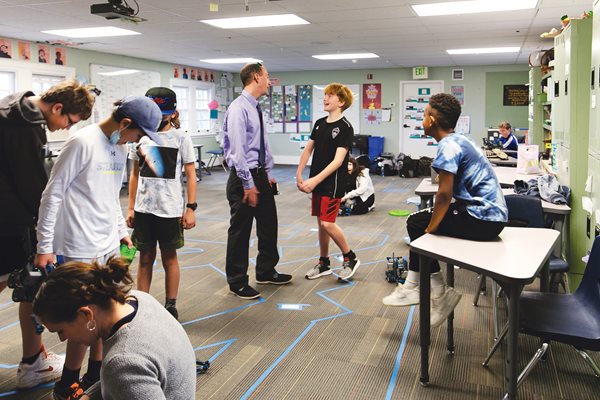 Greg Chalfin
Greg ChalfinHead of Middle School
Stanley British Primary School
Denver, Colorado
Photos by Sandra Jiménez
This is an excerpt from the NAIS Member Voices podcast. This is part of a three-episode series focused on fostering innovation.
What does innovation look like at Stanley British Primary School?
In March 2020, we went online and did the best we could like everybody else, and we got some good things out of it. But as we came into the 2020–2021 school year, we felt we had to be in person. Early in the pandemic, when, for safety reasons, we didn’t want to mix kids, we decided to try a block model in which students take one course intensively for four weeks in the middle school. A few staff members had gone to Colorado College and Cornell College, both of which use the block model, so we were familiar with it.We have about 50–55 students per grade in the middle school, so we had three cohorts of about 17 or 18 students. Each month we paired subjects, and students would study those two subjects as their deep learning. Part of the day was math, part of the day was science, and part of the day was an interdisciplinary connection co-taught by the two teachers. After a month, those students moved onto language arts and the arts. They read and performed Shakespeare. They took music and wrote poetry. They made lots of interdisciplinary connections. And then they moved onto social studies and Spanish for a month. After those three months, it was Thanksgiving break, and we were able to mix kids into different cohorts.
How did faculty deal with this change?
When I first introduced this idea to our faculty, they were apprehensive. They had to think, If you had to reduce your class down to one month of what’s most essential in the trimester, what would you do? But they were also really excited. Teaching that same month-long course for three consecutive months is going to make you better at it. You’re going to iterate it. You’re going to learn more. And you’re going to really prioritize your relationships with students because you’ve got one group of 18 kids as your whole class load.Before the school year, I had 30-minute conversations with each of the 20 to 25 faculty members to learn where they were, what questions they had, and what they needed. I drew on the people who had gone to Colorado College, and I also reached out to folks at the teaching and learning offices at Colorado College and Cornell College. I asked them to meet with our faculty via Zoom before the school year and then again in November. They were able to provide some really great advice, such as assigning fewer readings but asking students to do more with them, asking students to describe their problem-solving processes, and focusing on problem and project-based learning. These were things that were already baked into what we do pedagogically—really thinking about assignments as formative instead of summative.
Did the students contribute to the design of the learning experience?
As teachers oriented themselves to the learning, they wanted to hear from students about what would be exciting to pursue. For example, our seventh grade math and science team were doing a lot with time graphs, and kids were skateboarding down our carpool lane to figure out how fast they were going. Even though we couldn’t take field trips, we were able to use our campus in creative and innovative ways that gave agency to student voice and allowed students to make school feel as normal or as pre-pandemic as possible.Students also gave us feedback throughout the year. The initial feedback was, “We love it; we have two classes of homework instead of seven,” which is a total oversimplification. But at the same time, there was a kernel of truth that we needed to listen to: School was not overwhelming at a time when everyone already had enough to cope with.
What does the model look like now and in the future?
The model for the 2021–2022 school year was called the Bulldog Block Model 2.0. (Our mascot is the bulldog.) Some of our subjects stayed in a block model and some did not. It’s a hybrid three plus one: Students take three courses four or five days a week. These are the courses we felt needed yearlong consistency: Spanish, math, and English. We wanted to have a consistent writing component as well.But then—to use college terminology—students take what we call their “major.” These are four-week courses in which they have about double the amount of time as they have for any other class over four weeks. They’re able to do a dive deep with arts, social studies, and science. Now, instead of having one musical production in the eighth grade in which only one kid gets to play the lead, we have three four-week intensive blocks of the musical. There are three casts, and whether they went first or third in the rotation, they are able to support each other.
For science courses, we’ve been able to do creative scheduling to provide longer periods so students can go deeper with labs. We’ve been able to be project-oriented and immersive in the social studies sphere as well.
When you reflect on this initiative, what comes to mind?
I’m most proud that we were able to see it as an opportunity to grow as opposed to thinking about what we were losing. I'm also really proud of the way we have listened to student experience—and the way our teachers and advisers have been able to embrace this in the spirit of helping kids be in school and prioritizing their mental health. And I'm really impressed with the way our kids, our faculty, and our parents came together and were able to grow in each of their different roles.What are you reading, watching, or listening to that sparks ideas for innovation?
The Cult of Pedagogy blog by Jennifer Gonzalez is something I read consistently, and I listen to Angela Watson’s Truth for Teachers podcast. I continually come back to Loving Learning: How Progressive Education Can Save America’s Schools by Katherine Ellison and Tom Little, who was the head at Park Day School (CA). And I love Nel Noddings’ work on care theory in education.I’ve also been fortunate over the past couple of years to be involved in some professional development experiences through the NAIS Fellowship for Aspiring School Heads and through the Klingenstein Center’s FORGE program. The people I’ve met through those processes and experiences have been a big piece of my professional growth. Throughout the pandemic, I hosted a call for middle school heads for the Association of Colorado Independent Schools. There was no agenda; it was just a place to hear about things that were coming up in our schools.
A long time ago, a mentor told me that in this work, in administrative roles in particular, you have to seek out collaborative spaces. They’re not going to come find you. And so, that’s been an important part of my work, particularly throughout the pandemic.

Listen to the full interview on the NAIS Member Voices podcast. Download it now at iTunes, SoundCloud, TuneIn, or Stitcher. Rate, review, and subscribe to hear a new episode each month.
If you or someone you know would like to be part of Member Voices, drop us a line at [email protected].